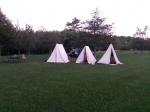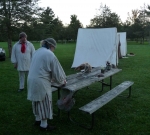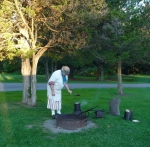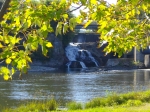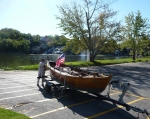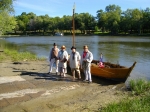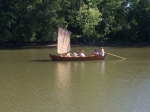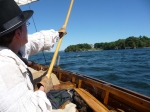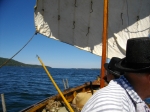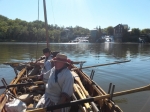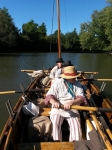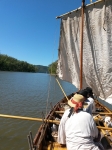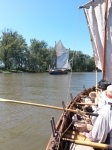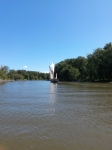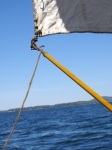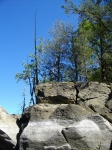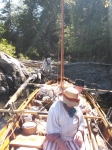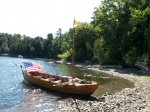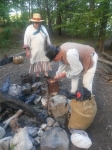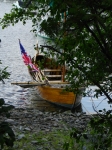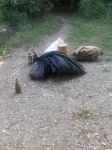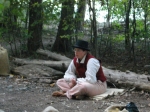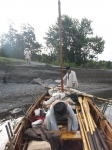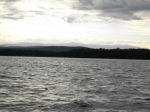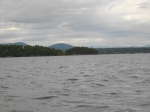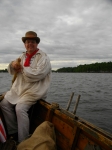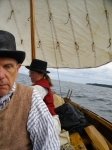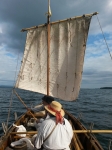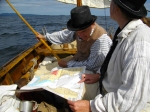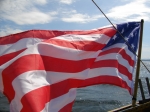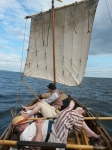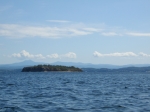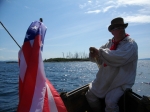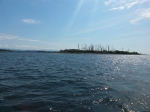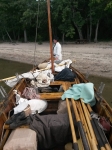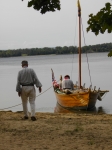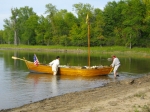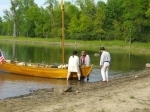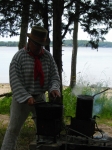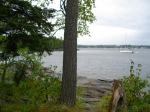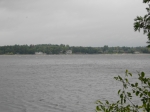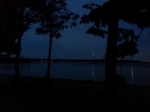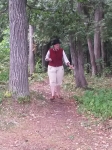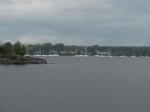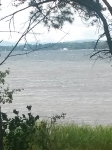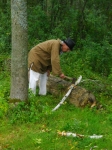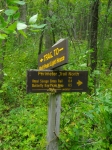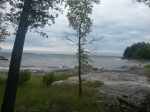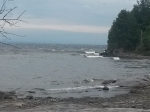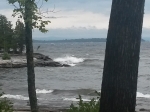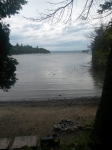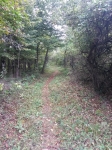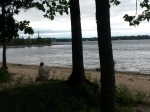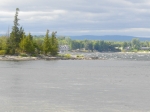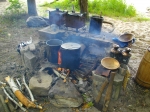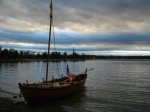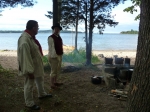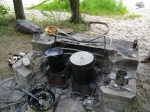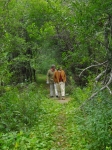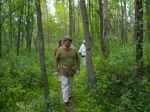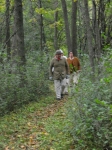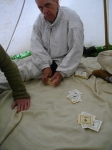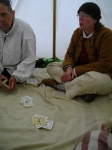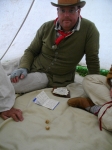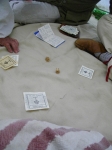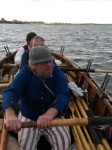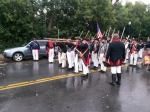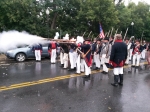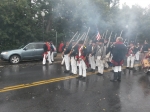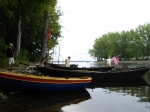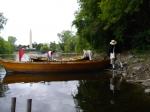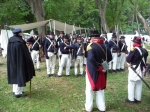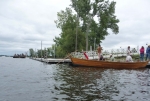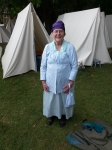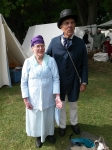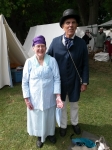Also known as ‘The Big Row, 2014’
Photos were taken by David Manthey, Bill Manthey, Kevin Richard-Morrow, and Erick Tichonuk. Video was taken by David Manthey and Ann Thomas. The photographs and videos are copyright by the person who took them. Text is by myself, David Manthey.
Monday, 8 September 2014 – Button Bay State Park
Even a few hours before, we did not know we would be at Button Bay State Park in Ferrisburgh, Vermont.
This year the Big Row is headed to Plattsburgh for the bicentennial of the battle of Plattsburgh, also known as the battle of Cumberland Bay. This was the major naval engagement which helped prevent the British army from advancing further into the United States, and was, arguably, a primary reason that America didn’t lose the War of 1812 as badly as it might have.
Because we traveled to Plattsburgh from Crown Point on the 2009 row, I was planning that this year we would start in Chambly, Quebec and head south. We would have crossed the Chambly basin, rowed up the Chambly Canal, stopped along the way for the night, then proceeded up the Richelieu River and up Lake Champlain. I was having some trouble reserving a campsite for the second night of this trip, but there are enough campgrounds along the Richelieu that I thought I could work it out.
Unfortunately for this plan, the wind forecast was very much against it. A week ahead of time, the forecast showed strong southerlies Tuesday through Friday. As the days progressed, Tuesday through Thursday remained obstinately southerly, whilst Friday’s forecast ranged from south to west and back.
On Sunday, I made the decision to reverse the trip from north-to-south to south-to-north. Rather than start in Chambly, I asked the rowers to meet at Crown Point. I thought based on information on the web that the campground at Crown Point would be open.
Today we hooked up the boat trailer and towed the Bobbie G from the Mabee Farm to Crown Point. To our surprise, the Crown Point campground had already closed for the season. A nearby private campground that was also listed as open was closed as well. Its proprietor told us that the closest open campground was Button Bay State Park. I called the other rowers and we changed the meeting location to Button Bay.
Button Bay State Park is a lovely campground with grassy sites and nice views. It was open and reasonably priced. Our second car of rowers arrived an hour behind us.
Reb suggested that we start just below the falls in Vergennes. This is close to the original site of Captain Thomas MacDonough’s shipyard, where some of the American fleet was built in 1814. We had heard a talk about the archeological evidence of the shipyard two years previously. This was a very pleasing notion – it gave us a reason for starting where we did, rather than just starting a handy distance from the end point in an arbitrary direction.
We only have four rowers and one boat for this trip. I thought we would have others, but they were not able to join us. Our crew of the Bobbie G is Kevin, Bill, Reb, and myself.
Tuesday, 9 September 2014 – Kingsland Bay State Park
We had a modestly leisurely start. We breakfasted on bacon and eggs, packed up the tents, and stored some gear in the boat and some in the cars. We drove over to the boat launch in Vergennes, just below Otter Creek Falls.
We loaded the boat while it was on the trailer, as it was more convenient than loading the boat on the shore or walking all of our gear the short distance to the Falls Park’s dock. As usual on our first day, loading is slow as we situate each item, attempt to keep the boat sensibly balanced, and try not to have too many duplicates. We elected not to have a swivel gun with us (or its mount). We do have the emergency bucket. Otherwise, the gear has become fairly standard for our rowing trips.
We asked a woman who was walking her dog to take a picture of the four of us in front of the Bobbie G. We climbed aboard and pushed off. Underway at last.
The first part of the row was very pleasant. We passed the boats owned by Lake Champlain Maritime Museum and used for community rowing. We passed where we thought MacDonough’s shipyard had been. We rowed by pleasant homes and crude camps.
Under our normal weekly use, the Bobbie G is a tight boat that doesn’t take on much water. Not so today. The boat has been out of the water for a week and is more heavily laden than usual. As such, seams that are normally tight or above the water are leaking. When there was a spare moment, the crew sponged out the water.
Occasionally there was enough wind that we hoisted sail. The wind would help for a brief spell, then abate or veer, usually because of the bends in the creek or topology of the surrounding land. We would dowse sail and resume rowing. We went back and forth repeatedly between sail and oars.
When we were around halfway between Vergennes and Lake Champlain, a familiar voice called to us from the shore. Erick from the Lake Champlain Maritime Museum had been driving to work and had spotted us under light sail. We spoke at a distance, then went our separate ways.
After six or so miles had gone beneath our hull, we decided it was lunch time. As usual, lunch was a mixture of sausages, cheese, bread, and fruit. Although we weren’t sailing quickly, we were sailing. It is always nice to gain distance without having to expend much effort.
We continued to alternate between rowing and sailing. After we had passed the boat launch near the mouth of the creek, we spotted an odd sailing vessel coming upstream. This turned out to be the Ceres. Later we learned that this strange-looking vessel is very loosely based on English barges, and built in a thoroughly modern manner. She was motoring up the creek and stowing her rig as we saw her.
A short distance later and we were out on the broad lake. The wind was very fresh, and was coming right off of the land on the Vermont side. This meant that we were sailing under a strong beam wind. The sailing ranged from pleasant to very heavy steering.
We covered the two miles between the mouth of Otter Creek and the cliffs at Kingsland Bay quite quickly. Steering was enough effort, though, that it felt longer. As we approached Kingsland Bay, the wind continued to freshen. I was glad when we were in the lee of the southern head of the bay and were able to strike the sail. It is the first time that I would have reefed the sail if I felt that we had the luxury of time and effort to do so.
We rowed into Kingsland Bay. I had a map of the state park, so knew where the “paddler’s” campsite was located. A woman was sitting on the rocks watching us come it. She scarcely acknowledged us and showed little or no curiosity.
We pulled up on the northern side of the spit of land that had the campsite, then relocated to the easy-access southern side. A short day of just 10 miles or so, but we were happy to be in camp anyway. We unloaded the boat. We elected not to pitch tents as the weather was fine and the temperature warm enough.
We spent the afternoon gradually getting our camp and dinner ready. I walked down the trail to the road; it was a fair distance, and long enough that I had no incentive to walk the further distance to the main part of the state park.
For dinner, Kevin made a lovely chicken with onion sauce, served with rice and spinach.
We turned in shortly after dark. The moon was near full and quite bright. The wind continued strong and variable.
Wednesday, 10 September 2014 – Valcour Island
As the weather forecast had predicted, today was mostly southerly winds, persistent but not excessive.
We were up with the dawn. We cooked breakfast of Rolf’s sausages and scrambled eggs. We broke camp and loaded the boat. We were under way before 8.
Our first stop was the main part of Kingsland Bay State Park in order to use the restrooms. We rowed across the bay. A sign on a concrete jetty prohibited mooring, and it wasn’t obvious how water visitors were supposed to approach the park. We pulled up on a gravel beach, which might be what was intended.
Handily, there was fresh water available near where we had landed the boat. We refilled out water containers and took turns using the park’s facilities. In short order, we were under way again.
As soon as we were beginning to nose out of the bay, we hoisted sail. With scant exception, we would be under sail all day. The wind was fresh, but not too strong. We scudded along, averaging between three and four miles per hour.
We passed Split Rock Point from a distance, staying closer to Thompson Point. We watched the Essex Ferry make its way back and forth, first ahead of us, then astern of us.
The wind remained favorable and not too fluky. We periodically adjusted braces or sheets to try to take best advantage of the wind and to make steering easier. Reb switched off with Bill for operating the whisker boom.
The Four Brothers gradually became visible then resolved into separate islands. One of them has a large number of bare trees. We saw the trunks sticking up before we could see the island. These trunks became anchored to land in time.
The morning passed pleasantly. We had rum call, ate peanut butter cookies, and watched the scenery go by.
Around noon we made a nature stop on one of the Four Brothers. The north side of this island was very shallow, so we weren’t able to pull in quite as close we would have preferred. This, combined with the wind, made landing and departing a bit more effort than we would have liked.
We ate lunch while under sail between the Four Brothers and Schuyler Island.
Five years ago, we had sailed this area at a speed that was uncomfortable. Moreover, there had been a difficult following sea. Today, the wind was fast enough to keep us moving well, but not with anything like the challenge of the last time.
We passed on the outside of Schuyler Island (the Vermont Side). After passing the island, I gradually steered closer to the New York shore, knowing that I wanted to pass on the west side of Valcour Island. We crossed a few shallow areas that were weedy.
The wind started to freshen, and I was glad to be in the comparative lee of Schuyler Island. As we approached Valcour, the wind also started veering to the east.
As we passed Bluff Point, we doused sail. The wind was now quite fresh and had a distinctly strong easterly component to it. We rowed past North Bay and into Butterfly Bay. I knew that the sandy beaches were day use areas, but they also offered the most protected camping spots in the current wind.
We landed in the center of the beach in Butterfly Bay. After talking with a visiting motor-boater and examining the area, we shifted the Bobbie G to the northeast end of the beach. Here we set up camp in the grassy area just out of the sand. It was somewhat tricky choosing a spot that was neither sandy, filled with poison-ivy, nor too lumpy.
Although Plattsburgh is only six miles away or so, the wind had freshened enough that we didn’t want to fight it and get to Plattsburgh at the edge of dark. Rather, we had a comfortable spot on a lovely island. The forecast for Thursday was brutal – a wind advisory was expected with 20 to 30 knot winds. This is too much for us to travel, so we encamped fully expecting to stay two evenings.
We unloaded the boat and set up two tents. I made a dinner of a period rice pilaf and salmon dish.
We watched the whitecaps as the evening settled in. We had covered 29 miles or so today.
Thursday, 11 September 2014 – Valcour Island
As forecast, today the wind was ferocious and we stayed on Valcour Island.
We woke at dawn, but, knowing that the wind was already too strong to allow us to safely travel, we arose slowly. We had our usual breakfast. Unlike our typical day, however, we had virtually no chores we truly needed to do, so we each were free to do as we saw fit.
The wind blew from the south or southeast very strongly. Later we would get a report that it had peaked at 47 knots on the nearby Cumberland Head. Locally it probably never exceeded 35 knots. The National Weather Service’s marine forecast had a wind advisory in place. This is equivalent to a small craft advisory, and we are most assuredly a small boat.
Since the wind was from the southeast, we were in the perfect spot on Valcour to ride it out. The upper trees flailed back and forth. Our camp remained mostly peaceful, not withstanding the occasional branch that broke off and fell nearby. Within our camp the wind was moderate. The water surface of the bay showed flaws of wind and catspaws. These were not particularly directed and often reversed.
To occupy ourselves, we collected firewood and made a fire. We examined the miniature pears that littered the ground in some areas and admired the gnarly pear trees. Reb started carving another wooden spoon.
I took a walk around some of the trails on the island and observed the more ferocious eastern side. In Smugglers’ Bay, the waves broke and foamed. Sloop cove, as always, provided a sheltered anchorage.
We played cards. We napped. We went in the tents to get out of the wind. We paced the shore.
I could easily imagine that if this wasn’t a park, we would have happily started constructing items to make our stay more pleasant. We could have built a table or chairs. We could have started a cabin. We could have made most anything possible out of trees that could be fashioned by axe and knife. I could imagine bringing a drawknife and spokeshave to facilitate this process.
The day passed slowly, but not unpleasantly.
Around 4 p.m., the wind suddenly stilled. The surface of the lake became dead calm and smooth. It was late enough it would have been imprudent to strike camp and head out right away, but we all stood up and contemplated it.
Within fifteen minutes of the calm, the wind returned, this time from the northwest. It blew 20 knots of cold air, and the surface of the lake became a sea of whitecaps. Now we couldn’t leave even if we wanted to. The temperature plummeted.
We made a dinner of boiled ham, potatoes, and green beans. We eyed the water and wondered what tomorrow would bring. We went to bed somewhat early, having nothing else to do.
Waves coming in to Smugglers' Bay
Friday, 12 September 2014 – Plattsburgh, New York
The night had continued windy from the northwest and north. The forecast was that the wind would be 15 to 25 knots in the morning, gradually diminishing to 5 to 10 knots by evening, with the waves diminishing as well.
We got up slowly, as once again, we knew that we wouldn’t be going anywhere soon. We had to shield our braziers in order to make breakfast. With the wind fanning the flames, even in the lee of the cement fireplace, we had the fastest time to cook coffee yet.
The day was cool and raw, with the wind constantly buffeting us. If one walked even 150 feet inland, the wind was blocked by the trees and didn’t seem that bad.
Every now and then, the wind would abate to the point that it looked like travel might be possible, only to renew itself after a few minutes. Each time it came back a little weaker than before. If we thought that we could set out, it seemed like the wind would increase and produce whitecaps just to assure us that we shouldn’t.
As with yesterday, we took walks, we played cards and dice, and we made a fire. Unlike yesterday, we were much more impatient. We wanted to get to the reenactment at Plattsburgh. We were tired of doing nothing in particular. The day wore away very slowly.
I contacted Katie who was supposed to meet us in Plattsburgh to help us get rides back to the cars in Vergennes to let her know that she would be there before us and not to worry.
Around three in the afternoon the wind fell again. We started packing up everything except striking the tents in hopes that this would be the time that the wind would die enough that we could go. It looked promising, so we struck the tents, doused the fire, and packed the last few items.
The wind had driven the Bobbie G hard ashore, so it was some work to get her floating again. We managed to set out right around four p.m. We had unstepped the mast and taken down the jack so as to present as small an area to the wind as possible. I also weighted the boat a bit more aft than when we sail to keep the bow high and less likely to dig in the waves.
With myself steering, the rowers gamely pulled. Having three rowers, one side is stronger than the other. Because of the wind angle, I decided to have the strength to starboard. This would help us work to the main New York shore a bit faster and counter the tendency that wind would cause to yaw to starboard.
As we rowed, the wind rose and fell. When it was strongest, it seemed like we were scarcely making any headway. When it died down a bit, we made good progress. Valcour Island gradually dropped behind us. Crab Island gradually came up.
Hard work. It was fortunate that it was only a six mile row. Around halfway through, we switched positions to let Kevin steer and myself row. We had Bill serve out a snack to keep up our energy. We rowed.
Kevin switched back to rowing. We continue to pull.
We reached the breakwater as the light was fading. The wind had calmed some, and I elected to go outside the breakwater so as to not have to steer amongst the moored yachts.
As we neared the mouth of the Saranac River, we saw another small boat that had just been launched making its way to the landing area. They got hung up on the sandbar at the mouth of the river. We navigated around the bar.
It was getting dark as we pulled past Champlain Park. We were greeted by friends. Most welcome. We pulled up to the shore where we knew we needed to tie up. Friends appeared and helped us secure lines, unload the boat, and haul gear up the hill.
After several trips to and from the boat, we got all of the necessary gear up to camp. We pitched our tents, talked with everyone who was already present, and wandered around, glad to be back in society after our wind-bound days.
We got Richie to go get us pizzas to eat while we set up camp. Normally I take the crew to dinner, but it was late and we still wanted to fetch vehicles, so I promised them breakfast on Saturday instead.
Once the camp was set up, Katie, Kevin, Reb, and I drove back to Vergennes. As we were leaving Plattsburgh, the fireworks were starting. It seemed a very long drive back to our starting point, considering that we had covered less than fifty miles by water.
The truck and car were where we had left them. We got all the drivers situated, stopped for gas, and headed back. We got back to Plattsburgh around one in the morning. Our trip was complete.
Saturday, 13 September 2014
This morning we had the luxury of not needing to do anything with the boat right away.
I had promised the crew breakfast at somewhere indoors where we would be served something other than scrambled eggs. A local had recommended a diner that was a few blocks away. The Campus Corner proved to be just what we wanted – a traditional diner with good food, a waitress who somehow kept up with three line cooks, and a cheerful local crowd for patrons.
After breakfast, we launched the DeSager, which Rick had driven up for the weekend. There is an annual race, the Plattsburgh Challenge Cup. As in years past, we would enter both boats. Since the DeSager is a leaner, lighter boat, we would race her to win. The Bobbie G would race to hamper others. Oddly, this is permitted, or perhaps even encouraged, in the rules.
The race started at 11 a.m. I think there were ten boats participating. We crewed out the DeSager with fresh rowers from our usual Tuesday night outings – Rick, Harvey, Tim, and Greg with myself steering. The Bobbie G has the rest of the crew from the rowing trip – Bill and Reb rowing with Kevin steering.
The wind was still strong, and the bay had quite a bit of chop to it. After discussion, the race organizers decided to shorten the race so as to not have the boats as far out in the chop.
We jockeyed for a good starting position. A musket was fired to start the race and we were off. The rowers did brilliantly, digging hard to get a clean start. Once we showed our stern to the rest of the boats, the DeSager would keep the lead for the whole race.
I knew that the sandbar would be an issue, as one had to cross or go around it on the way out and on the way back. I cut it as close as I could in our flat-bottomed boat, knowing the other boats would follow and get stuck. I didn’t witness what happened, being too focused on managing our own boat. However, reports were that at least three other boats did get stuck to the point that their crews had to disembark and wade in the water to get the boats unstuck.
We sped toward the buoy that marked the far end of the race. The water was choppy, but nothing that we hadn’t handled before. We rounded the buoy less crisply than I would have liked (my fault – I should have had the larboard side hold water briefly, not just come to oars). We were well ahead of the other boats as we rowed to the finish.
The Bobbie G did her job too, getting in the way of others. She caused at least one other boat to run up hard on the sandbar. She also caused other boats to go around or take more time than they would have otherwise. The DeSager’s victory was helped by the Bobbie G, so I view it as a group win.
In the afternoon, it rained lightly. The land troops did a brilliant looking military reenactment. This involved street-fighting down Cumberland Avenue. Our group’s unit is Giles Kellogg’s company, and we fielded quite a large number.
The street action was followed by the parade. Plattsburgh does what has to be the most involved city parade I have seen. It was smaller this year due to the rain, but still had quite a number of participants.
The afternoon and evening had a variety of events, all good, but not particularly relevant to the boats.
The DeSager finishing race
Sunday, 14 September 2014
Today was the main naval reenactment. There were ten small boats and three larger vessels involved. The Heron is still brand new, not yet done, and she had issues getting on station. The rest of us mostly did as was requested, each trying to portray a vessel that was vastly larger than what we have. I think it went fairly well overall.
After the naval reenactment, we put both boats back on their trailers. We gradually struck camp, then made our various ways home.
